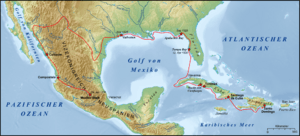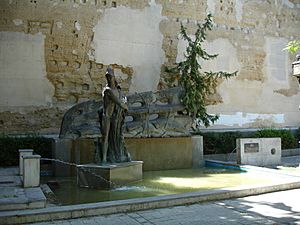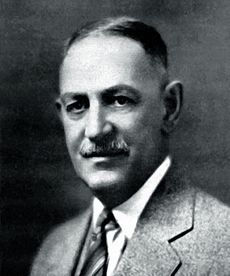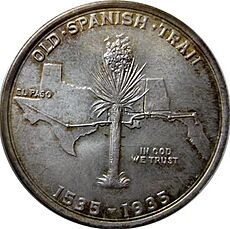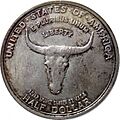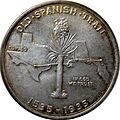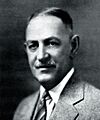Old Spanish Trail half dollar facts for kids
| United States | |
| Value | 50 cents (0.50 US dollars) |
|---|---|
| Mass | 12.5 g |
| Diameter | 30.61 mm |
| Thickness | 2.15 mm (0.08 in) |
| Edge | Reeded |
| Composition |
|
| Silver | 0.36169 troy oz |
| Years of minting | 1935 |
| Mintage | 10,000 with 8 pieces for the Assay Commission |
| Mint marks | None, all pieces struck at the Philadelphia Mint without mint mark |
| Obverse | |
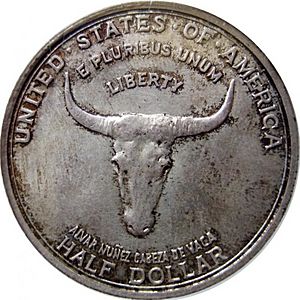 |
|
| Design | The head of a cow |
| Designer | L. W. Hoffecker |
| Design date | 1935 |
| Reverse | |
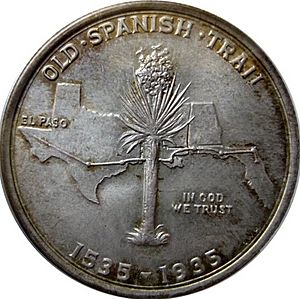 |
|
| Design | Yucca plant superimposed on map of the Gulf Coast states. |
| Designer | L. W. Hoffecker |
| Design date | 1935 |
The Old Spanish Trail half dollar is a special commemorative coin made by the United States Mint in 1935. It was designed by L. W. Hoffecker, who was a coin dealer. He was also in charge of selling these coins to collectors.
This coin celebrates the travels of a Spanish explorer named Álvar Núñez Cabeza de Vaca. He explored parts of what is now the southern United States in the early 1500s. Hoffecker chose this story for the coin, even though some of the details on the coin, like the route shown, were not perfectly accurate to Cabeza de Vaca's actual journey. For example, the coin shows El Paso, Texas, but Cabeza de Vaca never went there.
Despite these small historical differences, the U.S. Congress approved the coin. President Franklin D. Roosevelt signed the bill into law. Only 10,000 of these half dollars were made, which makes them quite rare and popular with coin collectors today.
Contents
What is a Commemorative Coin?
A commemorative coin is a special coin made to remember an important event, person, or place. Unlike regular coins, they are usually made in limited numbers and sold to collectors for more than their face value. The money raised often helps fund the event or organization being celebrated.
In the 1930s, the government didn't sell these coins directly. Instead, Congress would choose a group to buy the coins from the Mint at their face value. This group would then sell them to the public for a higher price. For the Old Spanish Trail half dollar, the El Paso Museum was chosen to handle the sales.
The Story of Cabeza de Vaca
Álvar Núñez Cabeza de Vaca was a Spanish officer. He was part of an expedition that landed near Tampa Bay, Florida, in 1528. The group was looking for treasure, but they faced problems with local Native American tribes. Cabeza de Vaca and others eventually became stranded.
They traveled west along the coast in small boats. He lived with the Karankawa tribe on Galveston Island for a time, acting as a medicine man. He then continued his journey overland, finally finding a Spanish patrol in northern Mexico in 1536. After returning home, he wrote about his amazing experiences.
The name "Cabeza de Vaca" means "head of a cow" in Spanish. It was said to be given to one of his ancestors by the King of Spain. This ancestor supposedly helped the army by marking a mountain trail with cattle skulls. This allowed the army to surprise and defeat their enemies.
The Coin's Designer: L. W. Hoffecker
Lyman William Hoffecker was a coin dealer from El Paso, Texas. He was also an important official in the American Numismatic Association (ANA), a group for coin collectors.
Hoffecker had tried before to get a commemorative coin approved in 1930. That effort failed when President Herbert Hoover vetoed the bill. But Hoffecker didn't give up. In 1935, after Hoover left office, he tried again. This time, he chose the Old Spanish Trail as the theme. He became the chairman of the El Paso Museum Coin Committee to manage the project.
He visited Washington D.C. and spoke with lawmakers. He even had a short meeting with President Franklin D. Roosevelt. Hoffecker later said this meeting "saved us," meaning it helped get the coin approved.
How the Coin Was Approved
The idea for the Old Spanish Trail half dollar started in the U.S. House of Representatives. A representative from Texas, R. Ewing Thomason, introduced the bill on March 4, 1935. He told the committee about Texas history and promised the coin would not cost the government any money.
The bill quickly moved through Congress. Lawmakers were told the coins were needed for celebrations happening that summer. They were also assured that the bill had support from both major political parties. The bill passed the House without anyone officially opposing it.
In the Senate, the bill also passed easily. Senator Duncan U. Fletcher of Florida recommended it pass. The Senate was told that the coin would actually make money for the government through seignorage (the profit made from minting coins). President Roosevelt signed the bill into law, allowing 10,000 half dollars to be made.
Hoffecker claimed that El Paso was the end of the Old Spanish Trail. This wasn't entirely true for Cabeza de Vaca's actual journey. However, Congress approved the bill anyway.
Designing the Coin
Hoffecker created the first drawings for the half dollar. He sent them to the United States Mint for approval. The Mint Director, Nellie Tayloe Ross, then sent them to the Commission of Fine Arts. This commission helps make sure that government art and designs are good.
The commission's sculptor, Lee Lawrie, thought the designs looked promising. He suggested a few changes. For example, the word "Liberty" was missing from Hoffecker's first sketches. Lawrie said it must be included and suggested placing it between the cow's horns. He also wanted Hoffecker's initials to be less noticeable.
An artist named Edmund J. Senn from El Paso was hired to create the detailed plaster models needed for the coin. The Fine Arts Commission didn't like the first version of the cow's head and asked for changes. Senn revised his models, and the designs were finally approved.
What the Coin Looks Like
The Front (Obverse)
The front side of the coin, called the obverse, shows the head of a cow. This design was chosen as a visual puzzle, or rebus, for "Cabeza de Vaca." Since no real portrait of Cabeza de Vaca existed, the coin uses the literal meaning of his name.
There are no other pictures on the front, just words. Coin experts have called this design "unorthodox" but also say it "tells the story" clearly without being too busy.
The Back (Reverse)
The back side of the coin, called the reverse, features a yucca plant in bloom. Behind the yucca is a map of five states along the Gulf Coast. A line on the map shows what is supposed to be Cabeza de Vaca's route, from Florida to El Paso. El Paso is the only city named on the map.
Other dots along the route are meant to represent cities like St. Augustine, Mobile, and New Orleans. However, this route is not historically accurate. Cabeza de Vaca mostly traveled by boat along the coast, not overland as shown. Also, the year 1535, which is on the coin, was not a major date in his travels. Hoffecker's initials appear near the year 1935.
Many collectors find the Old Spanish Trail coin to be "beautiful and very popular." However, some art historians have called the cow's head design "the ugliest commemorative coin ever produced."
How the Coins Were Sold
In June 1935, Hoffecker announced in The Numismatist (a coin collecting magazine) that he would be selling the Old Spanish Trail half dollars. He said he would sell them for $2 each, plus postage. He also promised that only 10,000 would be made and that he would try to make sure all collectors could get some.
The Philadelphia Mint made 10,000 of these half dollars in September 1935. They also made eight extra coins for testing. Hoffecker later said that he paid for and owned all the coins himself. He then sold them to collectors and other interested people. He tried to avoid selling to people who would just buy many coins to resell them for a higher price.
Hoffecker continued to sell these coins for many years. When his estate was sold in 1967, a group of 63 Old Spanish Trail half dollars was still found. Because only a small number of these coins were made, they are very popular with collectors who want to collect one of each different commemorative coin design.
The value of the Old Spanish Trail half dollar has increased a lot over time. In 1940, an uncirculated coin sold for about $4. By 1975, it was worth about $510. Today, a well-preserved coin can be worth over $1,000, and some exceptional ones have sold for over $25,000!
Images for kids


